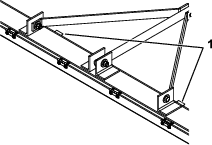Safety
Caution
The magnet may collect sharp or ferrous materials; contact with these materials could cause injury.
Do not touch the turf-facing side of the in-use magnet.
Danger
Strong magnets can adversely affect electronic health devices, such as pacemakers and defibrillators, when in close proximity and cause serious injury or death.
Consult a healthcare professional before using this product to understand your risk.
General Safety
This product is capable of causing personal injury. Always follow all safety instructions to avoid serious personal injury.
-
Read and understand the contents of both this Operator’s Manual and the operator’s manual of the traction unit before using this machine. Ensure that everyone using this product knows how to use this machine and the traction unit and understands the warnings.
-
Use your full attention while operating the machine. Do not engage in any activity that causes distractions; otherwise, injury or property damage may occur.
-
Do not put your hands or feet near moving components of the machine.
-
Do not operate the machine without all guards and other safety protective devices in place and working on the machine.
-
Keep the machine away from bystanders while it is moving.
-
Keep children out of the operating area. Never allow children to operate the machine.
-
Stop the machine, shut off the engine, engage the parking brake of the traction unit, remove the key, and wait for all moving parts to stop before servicing, fueling, or unclogging the machine.
Improperly using or maintaining this machine can result in injury.
To reduce the potential for injury, comply with these safety instructions
and always pay attention to the safety-alert symbol  , which means
Caution, Warning, or Danger—personal safety instruction. Failure
to comply with these instructions may result in personal injury or
death.
, which means
Caution, Warning, or Danger—personal safety instruction. Failure
to comply with these instructions may result in personal injury or
death.
Safety and Instructional Decals
 |
Safety decals and instructions are easily visible to the operator and are located near any area of potential danger. Replace any decal that is damaged or missing. |


Installation
Assembling the Magnet
Parts needed for this procedure:
| Tow bar | 1 |
| Tow bar support | 2 |
| Bolt (3/8 x 2-1/2 inches) | 1 |
| Washer (3/8 inch) | 2 |
| Spring washer (3/8 inch) | 1 |
| Nut (3/8 inch) | 1 |
| Bolt (1/2 x 3 inches) | 1 |
| Washer (1/2 inch) | 6 |
| Spring washer (1/2 inch) | 3 |
| Nut (1/2 inch) | 3 |
| Bolt (1/2 x 1-1/2 inches) | 2 |
| Wheel | 2 |
| Set collar | 4 |
| Serial decal | 1 |
-
Install the tow bar supports to the tow bar. Torque the bolt to 37 to 45 N∙m (27 to 33 ft-lb).
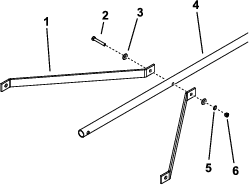
-
Loosely install the tow bar between the 2 middle brackets on the magnet housing.
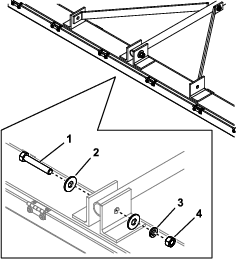
-
Loosely install the tow bar supports to the outer brackets on the magnet housing.
Note: Secure the supports on the inside of the brackets.

-
Install the wheels to the magnet housing.
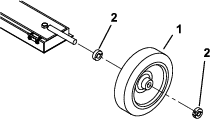
-
Tighten the screws on the set collars.
-
Install the serial decal near the Prop 65 decal on the magnet housing.
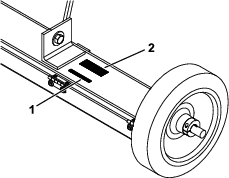
-
Secure the loop of the tow bar to a draw bar of a traction unit.
-
Adjust the height of the tow bar as needed so that the bottom of the magnet is parallel with the ground.
-
Torque the magnet housing bolts to 91 to 113 N∙m (67 to 83 ft-lb).
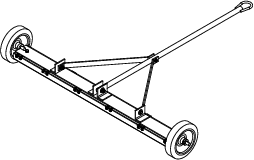
Operation
During Operation Safety
General Safety
-
The owner/operator can prevent and is responsible for accidents that may cause personal injury or property damage.
-
Wear appropriate clothing, including eye protection; long pants; substantial, slip-resistant footwear; and hearing protection. Tie back long hair and do not wear loose clothing or loose jewelry.
-
Use your full attention while operating the machine. Do not engage in any activity that causes distractions; otherwise, injury or property damage may occur.
-
Do not operate the machine when tired, ill, or under the influence of alcohol or drugs.
-
Never carry passengers on the machine and keep bystanders and pets away from the machine during operation.
-
Operate the machine only in good visibility to avoid holes or hidden hazards.
-
Keep your hands and feet away from moving parts.
-
Look behind and down before backing up to be sure of a clear path.
-
Use care when approaching blind corners, shrubs, trees, or other objects that may obscure your vision.
-
Disengage the attachment (if applicable) whenever you are not using it.
-
Stop the machine, shut off the engine, remove the key, wait for all moving parts to stop, and inspect the machine after striking an object or if there is an abnormal vibration in the machine. Make all necessary repairs before resuming operation.
-
Slow down and use caution when making turns and crossing roads and sidewalks with the machine. Always yield the right-of-way.
-
Reduce speed on rough roads and surfaces.
-
When the attachment is connected to a traction unit and in the raised position, the weight of it affects stability, braking, and steering. Exercise caution when transporting between working areas.
-
Never leave a running machine unattended.
-
Before leaving the operating position, do the following:
-
Park the machine on a level surface.
-
Engage the parking brake.
-
Lower the attachment.
-
Shut off the engine and remove the key.
-
Wait for all moving parts to stop before leaving the machine.
-
-
Do not operate the machine when there is the risk of lightning.
-
Use Bullseye accessories, attachments, and replacement parts only.
Slope Safety
-
Review the traction unit specifications to ensure that you do not exceed its slope capabilities.
-
Slopes are a major factor related to loss of control and rollover accidents, which can result in severe injury or death. You are responsible for safe slope operation. Operating the machine on any slope requires extra caution.
-
Review and understand the slope instructions in the manual and on the traction unit.
-
Evaluate the site conditions to determine if the slope is safe for machine operation, including surveying the site. Always use common sense and good judgment when performing this survey.
-
Review the slope instructions listed below for operating the machine on slopes and to determine whether you can operate the machine in the conditions on that day and at that site. Changes in the terrain can result in a change in slope operation for the machine.
-
Avoid starting, stopping, or turning the machine on slopes. Avoid making sudden changes in speed or direction. Make turns slowly and gradually.
-
Do not operate a machine under any conditions where traction, steering, or stability are in question.
-
Remove or mark obstructions such as ditches, holes, ruts, bumps, rocks, or other hidden hazards. Tall grass can hide obstructions. Uneven terrain could overturn the machine.
-
Be aware that operating the machine on wet grass, across slopes, or downhill may cause the machine to lose traction. Loss of traction to the drive wheels may result in sliding and a loss of braking and steering.
-
Use extreme caution when operating the machine near drop-offs, ditches, embankments, water hazards, or other hazards. The machine could suddenly roll over if a wheel goes over the edge or the edge caves in. Establish a safety area between the machine and any hazard.
-
Identify hazards at the base of the slope. If there are hazards, mow the slope with a power walk-behind mower.
-
If possible, keep the attachment lowered to the ground while operating on slopes. Raising the attachment while operating on slopes can cause the machine to become unstable.
-
Use extreme caution with other attachments. These can change the stability of the machine and cause a loss of control. Always keep the machine in gear when going down slopes. Do not coast downhill (applicable only to gear-drive units).
Operating Tips
-
Pick up metal materials by towing the attachment while driving forward.
-
Do not operate the traction unit in reverse while towing the attachment; otherwise, damage to the traction unit and attachment may occur.
-
Use caution while turning to ensure that the rear tire of the traction unit does not contact the attachment.
-
Do not operate the traction unit at speeds greater than 12 km/h (7.5 mph) while towing the attachment.
-
To clean the magnet, while wearing gloves, pull the release tray away from the magnet using the tabs and release the debris. Do not handle the debris with your bare hands; use a shovel or similar tool. Dispose of debris according to local and federal regulations.
